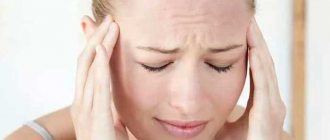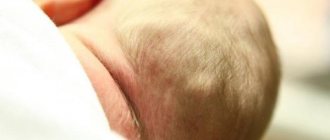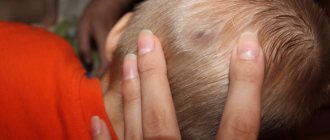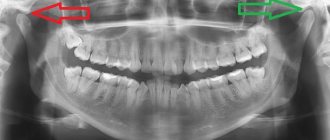Feels like needles are pricking your skin
This sensation is characterized in medicine by the term paresthesia. Many patients interpret it differently:
- Tingling.
- Burning.
- A crawling feeling.
These unusual sensations are associated with incorrect interpretation by the nerve centers of impulses coming from skin receptors.
A person associates such sensations with the skin, because it is on it that the feeling is formed, but most often the reason lies in the pathology of the nerves.
Possible reasons
To make it easier to make a diagnosis and refer to the right specialist, we will try to divide all the causes of tingling into groups according to two criteria: the place of occurrence of the symptom and its characteristics.
On the torso
If the tingling occurs only on the torso, then the intercostal nerves are most often involved. These structures arise from the spinal cord and run along the ribs throughout the body, innervating the skin of the chest and abdomen.
- Herpetic infection. This disease most often affects the intercostal nerves. The herpes zoster virus enters the body for the first time and causes chickenpox; after chickenpox is cured, the pathogen settles in the nerve ganglia and lies dormant there. When immunity decreases, the virus multiplies and causes a tingling sensation along the nerve root.
- Pinched nerve root. This condition is called sciatica. May be caused by injury or degenerative disease of the spine (osteochondrosis). As a result, a shooting pain, tingling or burning sensation passes through the body from the nerve root.
READ ALSO: Skin manifestations of endocrine diseases
Paresthesia and other conditions that will be discussed below in the text can cause paresthesia on the body.
If characteristic blisters with transparent contents, redness and itching appear on the skin of the chest or abdomen, then the diagnosis of herpes zoster is beyond doubt.
On the head
If the tingling sensation is localized only on the head, then you should think about the following problems:
- Vegetative-vascular dystonia. A complex symptom complex, the causes of which are not fully understood. In this condition, blood circulation in the head area is disrupted due to improper functioning of the autonomic nervous system. Possible factors may include overwork, injury, stress, viral and bacterial infections, smoking and alcohol.
- Tingling and a feeling of pulsation at the temple can occur with hypertension. The reason is increased blood pressure. The condition can be primary (more often in the elderly) or secondary (with pathology of internal organs). A cardiologist should understand the problem.
- An unpleasant tingling or burning sensation can also occur with eye diseases, fatigue, decreased vision, or wearing the wrong glasses or lenses.
- Sometimes the problem lies in the cranial nerves and their roots, which are affected by viruses of various groups.
Skin diseases can also cause tingling, this will be described in detail below in the text.
On the limbs
Shooting, tingling, or pins and needles on an arm or leg are almost always associated with damage to a large nerve. Possible reasons:
- Osteochondrosis.
- Nerve or back injury.
- Viral diseases.
- Strokes.
- Diabetes.
- Autoimmune diseases.
A neurologist will help determine the cause of local paresthesia and, if necessary, refer you to another specialist.
READ ALSO: How to get rid of blackheads - Lifehacker
All over the body
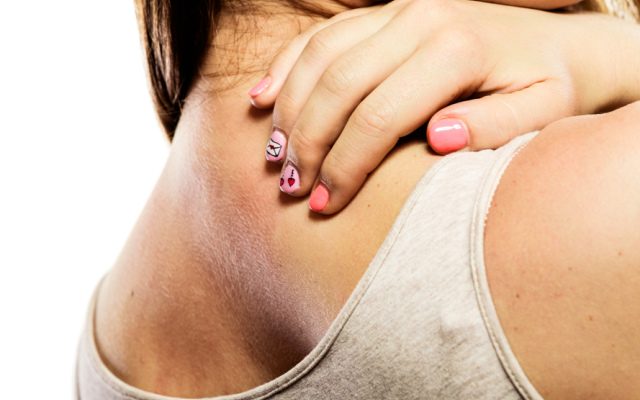
Finally, the most extensive group of causes is paresthesia in different areas of the skin. We list the possible factors of pathological feeling:
- Fungal diseases - very often cause itching on the skin and can cause tingling. They usually manifest themselves in the form of redness on the skin, so they do not go unnoticed by patients.
- Diabetes mellitus is a disease that most often occurs not only with polyneuropathy, but also with skin lesions. May cause tingling, itching and burning in a variety of areas of the skin.
- Alcoholic polyneuropathy is a very common condition that develops against the background of chronic alcohol consumption.
- Atherosclerosis is damage to blood vessels due to the deposition of cholesterol plaques inside. With this disease, the blood supply to the soft tissues is disrupted, and a tingling sensation occurs.
- Lack of vitamins, especially group B. These substances are necessary for the normal conduction of nerve impulses; their deficiency causes paresthesia.
- Dermatitis, eczema and other skin diseases. They can occur on any part of the body and can cause itching, tingling, burning and other various symptoms.
- Liver diseases. Impaired excretion of bilirubin by the liver leads to its deposition in the skin. As a result, not only jaundice occurs, but also itching throughout the body.
Causes of tingling in the head
Characteristic sensations in 90% of cases turn out to be a reaction of the tissues of the cranium to the influence of external factors. Irritation, muscle tension followed by relaxation, cooling of the skin after overheating can provoke a tingling sensation in the head, which is perceived as cephalalgia.
Even a hairstyle that is too tight can cause such consequences. The systematic influence of such seemingly safe factors threatens to increase sensitivity and disrupt tissue nutrition. Over time, this leads to organic failures in them.
Cervical osteochondrosis
With this disease, degenerative changes occur in the cartilage of the cervical spine. The tissues begin to compress the blood vessels and irritate the nerve endings. Oxygen ceases to flow to the brain in sufficient quantities, which leads to the development of hypoxia.
Clinical picture of cervical osteochondrosis:
- cephalalgia - at the initial stage, patients notice a stabbing pain in the head, which is localized in the occipital part. Over time, the pain spreads to areas behind the ears, neck, and upper shoulder girdle. As the pathology progresses, aching sensations in the skull are added, which become the result of oxygen starvation of the tissues;
- dizziness, lack of coordination, problems with perception;
- numbness of the skin of the back of the head, neck, shoulders;
- decreased functionality of fingers or entire limbs;
- nausea, sometimes vomiting, not related to nutrition;
- buzzing or tinnitus, hearing loss;
- pain and crunching in the neck when turning the head.

In the absence of specialized therapy, the disease will rapidly progress. Over time, this can negatively affect hand performance, intelligence, and mental health.
Overwork
Random colic of mild or moderate severity, which spreads over the entire area of the skull, often indicates a violation of the daily routine. Due to lack of sleep, excessive mental activity or stress, vascular tone changes.
Oxygen-rich blood does not actively supply the brain, while carbon dioxide-rich blood stagnates, poisoning the tissues. Taking analgesics does not give the desired effect; the unpleasant sensations do not disappear or quickly return. Ignoring symptoms and further non-compliance with the routine threatens decreased attention, dizziness, and loss of coordination.
Vegetovascular dystonia
The nature of the pathology is still not fully understood. Scientists only have theories about its causes, development mechanisms, and treatment methods. The outdated diagnosis includes a whole list of functional problems based on autonomic disorders. They manifest themselves in the form of neurological symptoms, signs of malfunction of internal organs.
Frequent symptoms of VSD:
- throbbing or stabbing pain in the head, which can have different intensity, location, and time of occurrence;
- drowsiness, feeling of heaviness in the skull;
- blood pressure changes;
- trembling in the limbs, swelling;
- slight increase in temperature;
- compression in the heart area.
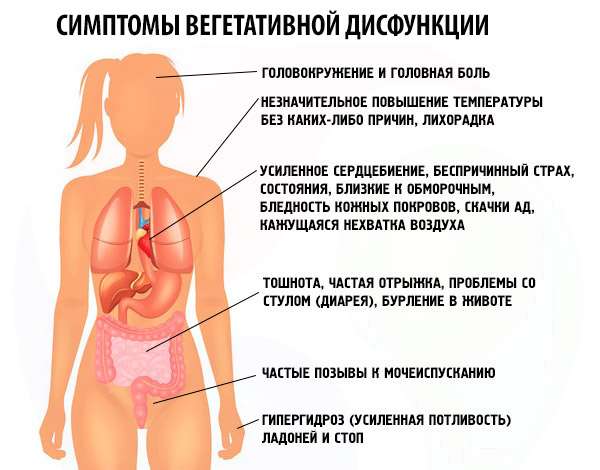
According to doctors, the likelihood of developing VSD increases against the background of overwork, chronic stress or emotional shock, and traumatic brain injury. The risk group includes people who abuse alcohol, take psychotropic medications, and have had viral diseases.
Migraine
The neurological disease most often manifests itself as a unilateral pulsation in the skull, but the sensations may be similar to tingling needles. They usually originate in the frontal part of the head or temples and gradually spread to the entire hemisphere. The clinical picture is complemented by dizziness, severe weakness, nausea and vomiting. Symptoms worsen with physical activity, under the influence of light, sounds, and smells. If you do not take the right actions at the start of an attack, it can drag on for a period of 3 to 72 hours.
Occipital neuralgia
The pathological phenomenon is accompanied by severe burning, cutting or stabbing pain in the head. The symptom is so intense that it is exhausting and does not allow you to do your usual activities. It is localized on one side of the back of the head at the site of damage to the nerve root. Shoots can radiate to the neck, ears, eyes, and lower jaw. Most often, attacks last a few seconds, but can last for minutes. Multiple repetitions of exacerbations are possible within a day. They often occur or intensify when moving, sneezing, coughing, turning the head sharply, palpating the affected area, or simply combing the hair.
Eye pathologies
Tingling in the head often occurs in people engaged in mental work, working at a computer, or overstraining their eyes. Unpleasant sensations cover the entire skull and are of weak or medium intensity. They intensify in the evening, complemented by lacrimation, redness of the mucous membranes of the eyes, irritability, and decreased attention. If you do not rest and do not fight the symptoms, the symptoms will intensify, the tingling in the head will be replaced by pulsation.
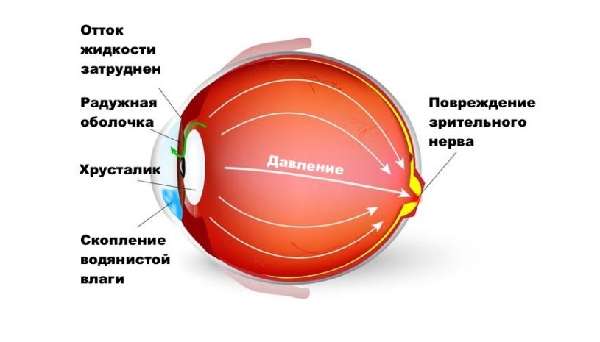
A pathological origin of the symptom cannot be ruled out. Specific sensations often accompany the development of glaucoma. The earlier the problem is diagnosed, the higher the chances of curing the disease. Refusal of therapy risks loss of vision.
Features of sensations
Let us also pay attention to the features of the clinical picture of the symptom.
If only tingling occurs, then the diagnosis is most difficult and extensive. It will be necessary to exclude all of the above conditions depending on the history and localization of the process.
But pain or itching will help to more accurately determine the cause.
Stitching pains

Stitching pain occurs with neuropathy. This condition does not occur with skin processes or liver diseases.
If a person has pain in the arms, legs or torso, it is necessary to look for the involved nerve and determine the cause of its damage. A neurologist will help with this and must examine such a patient.
The diagnostic search can be extensive:
They look at biochemical tests.
But itching is more typical for liver and skin diseases.
If the medical history does not indicate liver damage, then you should look for various skin symptoms - redness, rash, weeping and others. They can be hidden in various hard-to-see places.
Whiskey
Stitching pains in the head, or more precisely in the temporal part, are not always intense and pronounced. As a rule, they are simply ignored by people, because they can be tolerated even without painkillers. This position is incorrect, because discomfort of this kind can be a consequence of some disease. You will find information about them in the table in this section of the article.
| Disease | Explanation |
| Diseases of an infectious nature | The symptoms of these diseases are quite wide, and stabbing pain in the temporal part of the head may also occur. |
| Poisoning | In addition to pain in the temporal lobes, the following symptoms may be detected:
|
| Pheochromocyte | With this disease, the patient experiences increased production of adrenaline, and the consequence of this phenomenon is increased blood pressure. |
| Hypotension | To put it simply, the term refers to low intracranial pressure, which is also often a cause of discomfort. |
| Idiopathic intracranial hypertension | In this case, there is very high pressure in the head, and as a result, severe pain in both temples. |
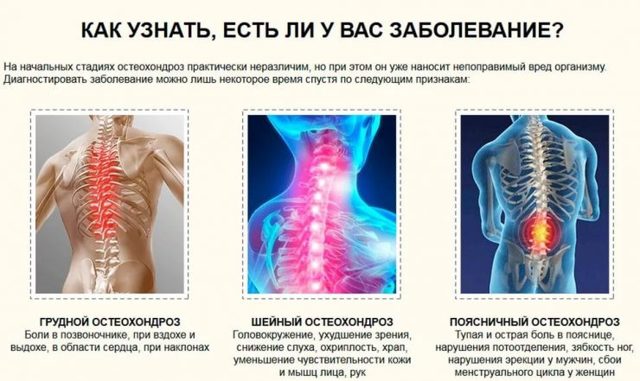
In addition, reasons may include:
- pressure on nerve endings;
- chronic lack of sleep;
- menstrual cycle;
- gassing;
- starvation;
- being at high altitude (since in this case absolutely everyone has increased intracranial pressure).
Could it be due to allergies?
Tingling and itching may be a sign of an allergic reaction. This process occurs with atopic dermatitis and urticaria.
If characteristic blisters appear on the skin, then the diagnosis is beyond doubt. Urticaria should be treated with antihistamines and the allergen should be eliminated.
Atopic dermatitis may be hidden from examination, but sooner or later redness, peeling of the skin, cracks or weeping are detected on the skin.
What to do?

From all of the above, we can conclude that there are quite a few causes of the symptom, and each of them requires different treatment.
- Antihistamines.
- Antibiotics.
- Glucocorticosteroids.
- Antifungal.
- Antiviral.
- Vitamins.
- Hepatoprotectors.
- Nootropics.
If you don’t know why you have discomfort on your skin, consult a therapist. A general practitioner will examine you, sort out the problem and refer you to the right specialist.
News MirTesen
Diagnostics and differential diagnostics
If the symptom recurs frequently, the patient should consult a doctor who will conduct an examination and take a medical history. The patient's blood pressure, temperature and pulse are measured. Diagnosis consists of general and biochemical blood tests. If the need arises, computed tomography and magnetic resonance imaging are prescribed.
Treatment of a pathological condition directly depends on the causes of its occurrence. Therapy for colic in cervical osteochondrosis is carried out using non-steroidal anti-inflammatory drugs, physical therapy, massage, and physiotherapy. The patient must take nootropic and analgesic drugs, as well as chondroprotectors.
An integrated approach is recommended in the treatment of vegetative-vascular dystonia, which will eliminate unpleasant symptoms and strengthen the body. The patient is recommended to use sedatives, diet therapy, and vitamin complexes. If a person is overtired, it is recommended to take proper rest. Experts recommend the use of massage and relaxation techniques. When overworked, aromatherapy and baths with sedatives - chamomile, mint - are used.
For migraines, headaches during attacks are relieved with analgesics, nonsteroidal anti-inflammatory drugs, ergotamines, and triptans. To prevent exacerbation, it is recommended to adjust your lifestyle, use a diet, and take medications.
For occipital neuralgia, muscle relaxants, non-steroidal anti-inflammatory drugs, anticovulsants, and analgesics are taken. The use of sedatives, vitamin complexes, massage, and physiotherapy is recommended. If there is no positive therapeutic effect, then the person should take steroid drugs.
For stabbing pain, it is recommended to relieve symptoms, which will provide relief to the patient’s condition. To eliminate the cause of the pathology, it is recommended to undergo a course of treatment, which is prescribed by a highly specialized specialist.
The occurrence of tingling in the head indicates an incorrect lifestyle of a person or the progression of diseases. If a symptom is observed for a certain time, the patient should seek help from a doctor who will correctly diagnose and prescribe effective treatment.
Before starting treatment, you must find out what caused the burning and heat in your head. You need to visit a therapist, neurologist and possibly other specialists, take general blood and urine tests, and also make an appointment with an ophthalmologist. This is an initial consultation with doctors.
In addition, an X-ray of the skull is taken, a CT scan or MRI (magnetic resonance imaging) is performed. In this case, a standard set of studies is used.
If an anomaly is suddenly discovered in the brain area, then to accurately determine the disease it is necessary to undergo a tomography. This is the best method for diagnosing diseases in the head area. The patient is placed in a tomograph.
Its principle is based on the effect of hydrogen protons on the human body. After this, encephalography (or ultrasound) is prescribed. The patient's head is lubricated with Vaseline and an ultrasonic sensor is passed over it. The received data is displayed on the monitor. They need to be recorded and decrypted.
The last stage of the examination is electroencephalography. This method is based on recording nerve impulses emanating from the brain.
Using electroencephalography, you can find out in which part of the head the disorder occurred. All of the above methods of examining the head are painless, but effective in identifying serious diseases.
In the process of general diagnostics, the following facts are revealed:
- frequency of pain in the form of burning and tingling;
- the connection between pain and the body’s response to pain;
- nature of pain, intensity, duration, localization.
Differential diagnosis is a method that allows you to identify a disease in a person by excluding possible diseases due to the patient’s lack of obvious symptoms of the suspected diseases.

As a result, the correct diagnosis is made and proper treatment is carried out. There are special computer programs that help to most accurately identify the disease based on the detected symptoms.
Before starting pain treatment, a number of tests are carried out, including laboratory tests - they can look for signs of infection and inflammation. A visit to an ophthalmologist is mandatory for the patient.
A visit to this doctor is indicated in almost all cases of headaches, since there may be changes in the fundus of the eye that can only be determined by an ophthalmologist using special equipment; The examination also establishes the true cause of the headache. Plus, the ophthalmologist will evaluate the state of refraction, visual acuity and visual fields of the patient.

